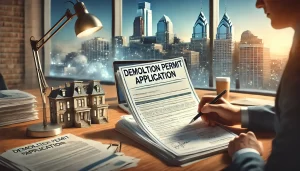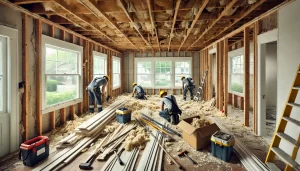As we stride into the future, our cities are constantly evolving, finding new ways to repurpose old spaces. Take, for instance, the ambitious NexusPark Development, set to breathe new life into 100,000 square feet of space with physician and health offices, a fieldhouse, a fitness center, and more. Or consider CityCenter Englewood’s successful transformation of the 1960s-era Cinderella City Shopping Mall into a thriving community hub.
Yet, it’s not just about the physical transformations. It’s about fostering community engagement, a strategy employed by Pacific Retail in their redevelopment projects. This approach bolsters faith in the project’s vision, ensuring its ultimate success.
Join me as we delve into the benefits of revitalizing retail spaces and the potential that lies in the rubble of mall demolitions. Together, let’s explore how these transformations are shaping our cities and communities for the better.
The Current State of Retail Malls
Observing the progressive metamorphosis of retail spaces into flourishing community hubs evidences the potential inherent in repurposing. This section delves into the present predicament facing retail malls and demonstrates a possible pathway towards rejuvenation.
Trends and Challenges
Shopping malls in today’s world face an uphill battle. Traditional stores confront significant competition from e-commerce platforms, with online sales taking a considerable share of the retail market. Additionally, consumer preferences have pivoted towards experience-driven shopping over mere transactions. Consequently, a rising number of malls are finding themselves increasingly irrelevant, resulting in declining footfall and vacant stores.
Notably, a Sears department store, formerly part of the bustling Irondequoit Mall near Rochester, symbolizes this trend. Its demise underscores the ongoing challenges in the retail industry. Amidst such trials however, lies a unique opportunity for reinvention.
The Case for Demolition
Enter the realm of mall demolition. It’s a radical solution, but one that provides significant potential for transformation. This approach is particularly appealing for large vacant spaces like the Sears store, where various factors make a revival unlikely.
Demolishing these spaces can pave the way for mixed-use development projects, as demonstrated by the case in Englewood. Having recognised the mixed-use development’s potential, they engaged with city authorities for support. Upon attainment of zoning amendments and gap funding, the mall underwent a complete demolition, paving the way for an open-air project.
The radical transformation included a diverse mix of housing, retail, entertainment and office spaces, with the city hall and public library repurposed from an old department store building. Thus, the demolition served as a catalyst for change, reinforcing the city’s presence and transforming an old mall into a lively community center.
These events affirm that sometimes, to build something new and vibrant, demolition, though harsh, might prove necessary.
Economic Impact of Mall Demolition
Demolishing malls and repurposing the spaces for new developments can have substantial economic implications. This process not only stimulates job creation but also has long-term economic benefits, revitalizing local economies, and fostering business diversity.
Job Creation Through New Developments
Tearing down decrepit malls and building new establishments significantly impacts local job markets. Every new construction and development generates a multitude of employment opportunities. Temporary jobs arise during the construction phase, such as laborers, architects, engineers, and project managers, enhancing the locales’ employment rates. Following the construction phase, the completed establishments, whether they’re residential, retail, or recreational, also create permanent jobs in various sectors such as property management, customer service, entertainment, and healthcare. For instance, at the Nexus Park development project, this phenomenon is apparent with stats suggesting a substantial impact on local employment.
Additionally, consider the experience from Tiny Tim Plaza’s transformation. The stakeholders engaged the existing businesses individually, providing assistance during the construction process, thus sustaining and potentially bringing about new employment opportunities.
Long-Term Economic Benefits
Aside from job creation, the economic revitalization through mall demolitions has profound long-term impacts. A classic example is the CityCenter Englewood, a development that replaced the 1960s-era Cinderella City Shopping Mall. The development includes open spaces, retail entertainment, residential, and transit points, offering a pedestrian-friendly atmosphere.
New developments increase tax revenues with enhanced property values and new businesses. They also attract new business integrations and startups, diversifying economic activities, and reducing community reliance on a single industry. Additionally, once-neglected and under-utilized spaces are given a new lease on life, driving up the surrounding property values. This transformation into productive, vibrant spaces can attract residents, businesses, and visitors and ultimately boost the local economies.
Overall, the demolishing of malls offers clear economic benefits. It creates jobs, revives economies, and revitalizes communities, proving to be a strategic approach to urban development.
Environmental Considerations
In the redevelopment narrative, I explore the crucial aspect of environmental considerations, focusing on demolition processes and sustainable strategies in new construction.
Demolition and Recycling Processes
Demolitions of large structures, such as malls, confront numerous environmental challenges, and meeting these requires careful planning and execution. Initially, a detailed demolition plan ensures the salvage and recycling of viable materials, reducing waste. For example, recycling concrete or bricks can significantly lessen the pressure on natural resources. As a part of the process, asbestos management becomes a critical concern, often requiring professional abatement to ensure safety and environmental protection. Stripping malls of hazardous materials strengthens the case for redevelopment, factoring in both the environmental benefits and the public health benefits.
Sustainability in New Construction
Sustainable methods are vital in new construction processes in redevelopments like Englewood City Hall and PowerCityCenter. Integrating green building practices, such as LEED certification standards, optimizes the use of resources, reduces waste and creates healthier, more energy-efficient structures. A smart design that incorporates features like natural lighting, optimal space utilization, and energy-efficient systems prove pivotal in accomplishing sustainability goals. This strategic planning yields enhanced living spaces that are as efficient as they are aesthetically pleasing. In a nutshell, sustainable new construction comes with positive environmental footprints, leading to healthier and more resilient communities.
Community and Cultural Rejuvenation
Demolishing malls often provides the chance to rejuvenate communities and local cultures, giving way to compelling developments that breathe new life into areas.
Enhancing Local Identity
Demolishing obsolete retail structures paves the way to restoring and enhancing local identity. For example, Community Development Partners, a California-based affordable housing developer, co-led the transformation of a Southern California strip mall into a mixed-use property. This rejuvenated venue now boasts affordable multifamily housing and a community-serving space. Similarly, real estate developer Amy Casciani and PathStone undertook the conversion of a former Sears anchor store into an affordable housing property for seniors. Both redevelopment projects perfectly demonstrate how revitalizing retail spaces can reinvigorate local identities and contribute to community sustenance.
Opportunities for Public Spaces
Mall demolitions often open up opportunities to create public spaces that build communal bonds and promote active living. An instance of such progress is seen in Pacific Retail’s current redevelopment project. The former Galleria at White Plains Mall, roughly 30 miles north from Manhattan, is undergoing a transformation. The plan for this 900,000-square-foot former shopping and dining destination includes it becoming a residential and entertainment district that houses thousands of apartments and open green spaces. The green spaces intended in the project support the concept of an ’18-hour neighborhood’, prompting people to spend more time in these areas, thereby contributing significantly to bolstering social ties and facilitating vigorous community living.
Case Studies of Successful Mall Transformations
In this section, I focus on illustrating the process and benefits of mall transformations. I showcase successful projects that demonstrate how underutilized malls can transform into vibrant, sustainable, and community-friendly spaces.
Conversion into Mixed-Use Developments
What was once the Macy’s department store at Westside Pavilion in Los Angeles, now rebranded as West End, underwent a significant transformation to exhibit the potential of adaptive reuse. HLW, an architectural firm, transformed the structure into 230,000 square feet of creative office space. This redevelopment served as a catalyst instigating the larger repositioning of the former mall, signifying the areas’ rebirth.
Another such transformation involves the Bayfair Center in San Francisco’s East Bay. Both the West End and Bayfair Center transformations highlight how vacant malls can breathe new life into an aging retail space, stimulate economic activity, and align with sustainable urban development objectives.
Innovative Community-Centric Projects
The possibilities for repurposing vacant malls extend far beyond the typical conversions into housing or office spaces. Many innovative projects have reimagined these spaces into cultural hubs, educational campuses, and medical centers.
For instance, some communities have turned vacant malls into indoor farms, leveraging the extensive square footage for sustainable food production. Similarly, public amenities like libraries, community centers, and parks have been introduced into these spaces, adding value to neighborhoods and fostering a sense of community.
A promising example is a recently converted office space into vertical farm spaces, utilizing the sizable area that is often characteristic of former malls. The transformation of these spaces offers an exciting potential for creative, environment-friendly, and socially beneficial repurposing of dormant retail sites.
Conclusion
Revitalizing retail spaces through mall demolition isn’t just about tearing down old structures; it’s a strategic move that can yield significant economic, environmental, and social benefits. Job creation, sustainable construction, and community rejuvenation are just the tip of the iceberg. With careful planning and a focus on sustainability, we can transform these dormant sites into vibrant, community-friendly spaces. Connecticut demolition projects such as Enfield Mall have shown us the potential of such transformations. And it doesn’t stop at traditional conversions; we can get creative, turning malls into indoor farms, cultural hubs, and more. So, let’s continue to rethink, repurpose, and revitalize our retail spaces for a healthier, more resilient future.










